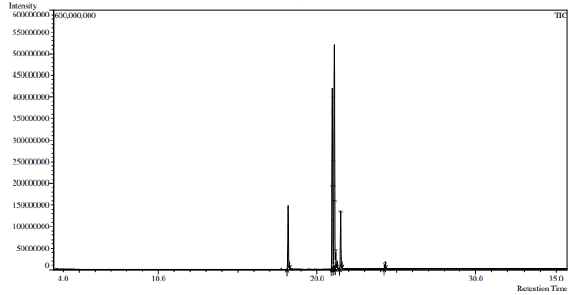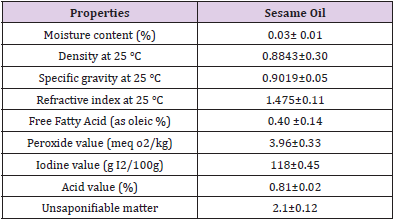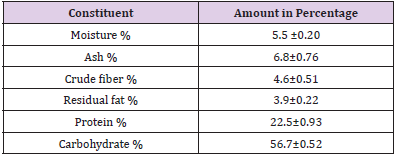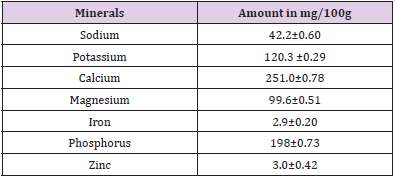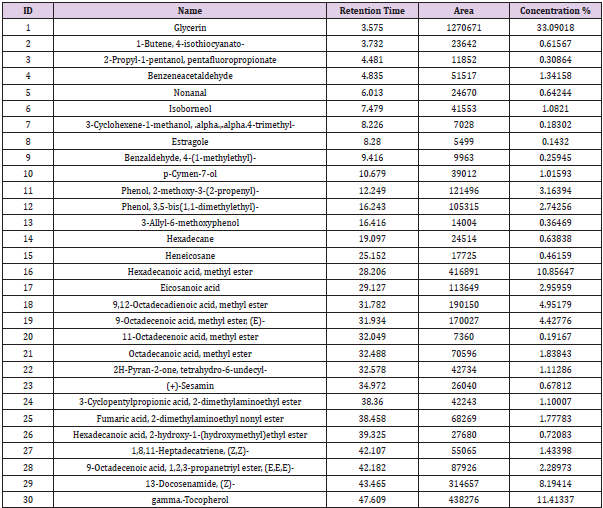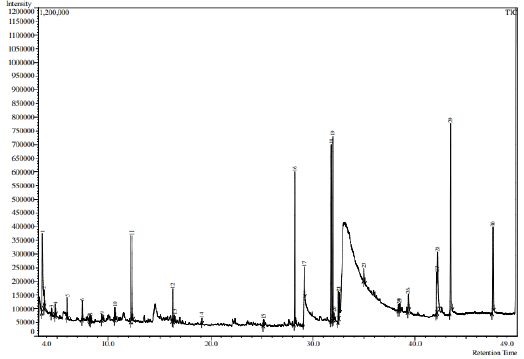Abstract
Oil was extracted from sesame seed by hydraulic press and the physico-chemical characteristics such as moisture content, density, specific gravity, Refractive index, free fatty acid, acid value, iodine value, peroxide value and unsaponifiable matters were determined. Proximate analysis of defatted seed meal were done. The residual oil was extracted by organic solvents as the residual oil deteriorates and degrades the quality of seed meal during the storage. The carbohydrate content in defatted meal was found to be the highest (56.7%) and protein was 22.5%. The major minerals such as Ca, Mg, Na K, Fe and Zn were estimated by AAS. It was found that almost all the mineral contents were higher except Fe (2.9 mg/100g) and Zn (3.0 mg/100g). Presence of highly toxic and carcinogenic aflatoxin in seed meal was detected by applying ELISA (enzyme linked immunosorbent assay). Aflatoxin found in seed meal was very low, 0.113 ppb than allowable limit (4 ppb) for human consumption. Fatty acids composition of the oil was determined by GCMS that revealed 6 fatty acids. Further, GC-MS study of the seed meal confirmed the presence of thirty bioactive compounds with glycerin 32.77% as predominant and maximum number of phytocompounds were observed.
Keywords: Oil; Sesame Seed; Meal; Minerals; Protein; Aflatoxin; Fatty Acids; Phytochemicals
Introduction
Sesame (Sesamum indicum L.) is an economically and
nutritionally important crop and it is prized for oil. The global
sesame market demand is rising with increasing health awareness.
Sesame is one of the oldest oilseeds and is widely cultivated in
both tropical and subtropical areas. Worldwide sesame seed
consumption was USD 6559.0 million in 2018 and it will reach USD
7244.9 million by 2024, with a CAGR (compound annual growth
rate) of 1.7% [1] In Bangladesh, sesame is an important summer
oilseed crop occupying 9.4% of the total oilseed area [2]. Sesame
is labeled as the queen of oilseeds because of its high oil content
(35-45%), delicious nutty aroma, and flavor [3] and a considerable
amount of proteins, carbohydrates, essential minerals. Seeds
contain high amount of methionine and tryptophan, fibers as well
as secondary metabolites such as lignans, saponins, flavonoids,
and phenolic compounds. Moreover, the seeds are a good source
of calcium, phosphorus, iron, small amount of trace elements and
are rich in vitamin B, E. Sesame oil has a pleasant, mild taste and is
remarkably stable.
It has a high content of polyunsaturated fatty acids as oleic
and linoleic acid. Sesame oil cake is good feed for poultry, fish,
cattle, goat and sheep [4]. Oil cakes, the coarse residues after the
removal of oil from various oilseeds is usually treated as waste
products in Bangladesh. The average total production of oil cakes in
Bangladesh is about 1,70,000 tons per annum [5]. Oil cakes are rich
in protein and minerals, but their inherent values have never been
considered actively. They are generally used as poultry and other
animal feed or as fertilizer. Among the total production of oil cakes
in Bangladesh, 70% of which are used as fertilizer, 10% is being exported and the remaining 15% is available for animal feeding [6].
Sesame Oil cakes or defatted sesame meal can be an ideal source
as a support matrix for various biotechnological processes for the
production of enzymes, antibiotics, vitamins, antioxidants [7] and
various food products. So, the sustainable utilization of this seed
meal is necessary for preparing cattle, poultry and fish feed and
also for the preparation of protein and vitamin enriched food stuff
for men and poultry, fish farming.
The present work had therefore, been undertaken with a view
to finding out the major constituents of the sesame seed oil and
defatted seed meal so that the proper and effective utilization of
these seed meal may be ensured.
Materials and Methods
Sesame seeds were purchased from katakhali bazar, Rajshahi,
Bangladesh. Then the seeds were cleaned, dried and the oil was
pressed out by hydraulic press. The meal thus obtained were freed
from residual oil by solvent extraction. The residual oil was extracted
in a Soxhlet apparatus with n-hexane. This solvent was selected
as extraction solvent because it has better effect over other polar
solvents like alcohol, ketone, aldehyde etc. [8]. Physical properties
such as moisture content, refractive index, density, specific gravity
and viscosity of the oil were determined by the method described
by Garba, et al. [9] and AOAC [10]. Acid value, saponification value,
iodine value, peroxide value, unsaponifiable matter and free fatty
acid were estimated according to the AOAC [11].
The defatted seed meal were air dried, and analysis of nitrogen
was carried out by Micro-Kjeldhal method, and the percentage
of protein was calculated [12]. The defatted meal was also used
for different analysis like ash [13], fiber [14], carbohydrate [15],
residual fat [16] and moisture content [17]. The minerals such as
calcium, potassium, phosphorous, magnesium, sodium and iron
were determined by atomic absorption spectroscopy (Model:
AA-68000, Shimadzu, Japan) coupled with an auto-sampler (ASC-
6100). The fatty acid composition of the sesame oil and the chemical
compound of seed meal were analyzed by SHIMADZU GC-2010 was
equipped with auto-sampler (AOC- 20s), auto-injector (AOC-20i)
and SH Rxi 5MS Sill capillary column with 30m×0.25mm×0.25 μm
film. Detection of aflatoxin in seed meal is done following by the
method Lee & Rachmawati [18] (Figure 1).
Results and Discussion
Moisture, Density, specific gravity and refractive index of sesame oil were determined and depicted in Table 1. All values were within the WHO/FAO permissible limits. The results showed in Table 1 that the free fatty acid, acid value, peroxide value, iodine value and unsaponifiable matters of oil were 0.40%, 0.81%, 3.96 meq O2/kg, 118g I2/100g and 2.1 respectively. These results were similar to those reported in other studies [19-21]. The proximate analysis of defatted sesame seed meal were determined, and the results were given in Table 2. It was found that the protein content of meal was 22.5% and the carbohydrate content was the highest, 56.7%. The content of crude fiber was 4.6% whereas moisture, ash and residual fat content were 5.5%, 6.8% and 3.9% respectively. All values were in an appreciable level. Table 3 showed the mineral contents of defatted sesame meal. Sesame meals contain good percentages of minerals which may added better nutritive value for foods or in pharmacological preparations.
Scientists are looking for an alternate source of cheaper oil cake with low level of aflatoxin. The literature on the incidence of aflatoxin in sesame oil cake is scanty. Mirocha, et al. [22] reported the presence of Fusarium toxins in sesame seeds. While Laxma Reddy and Reddy [23] observed the incidence of trichothecene producing fungi was low as compared with that of Aspergillus and Penicillium species in sesame oil cake. The allowable limit of aflatoxin for human consumption is 4 ppb [24]. Aflatoxin of seed meal was determined shown in Table 3 is 0.113 ppb that is much lower than allowable limit for human consumption. The fatty acid composition is an essential indicator of the nutritional value of the oil. Sesame seed oil belongs to the oleic–linoleic (mono unsaturation-poly unsaturation) acid group. It has 25% poly unsaturated fatty acid, 9,12-Octadecadienoic acid methyl ester and 31% mono unsaturated fatty acid, 9-Octadecenoic acid methyl ester. Oil also consists of palmitic acid 22%, stearic acids 19% and Heneicosanoic acid, methyl ester 2.4% (Table 4).The chemical compounds of sesame seeds were analyzed by GC-MS and summarized in Table 5 and their GC-MS chromatograph in Figure 2.
GC-MS analysis of sesame seed meal identified 30 chemical
compounds representing the highest yield, 32.77% of glycerin and
11.4% gamma-tocopherol (vitamin E), 10.85% hexadecanoic acid
methyl ester and 8.19% 13- docosenamide depending on relative
area. Glycerin has antimicrobial and antiviral properties. Gammatocopherol
is the main component and represented about 90.5% of
total tocopherols, shows a higher antioxidant capacity as compared
to alpha-tocopherol. Sesame oil rich in tocopherols and in lignans
(notably sesamin and sesamolin) provide exceptional oxidative
stability compared with other edible oils [25]. Hexadecenoic acid,
methyl ester possesses antioxidant and anti-fungal property [26]
and the presence of 13-Docosonamide impart antioxidant activity [27]. It was also found that there were some compounds in lower
concentration including Phenol, 2-methoxy-3-(2-propenyl)-, 3-Allyl-
6-methoxyphenol, 2-Propyl-1-pentanol, pentafluoropropionate
that have antimicrobial activity [28].
Compound found in meal Phenol, 3,5-bis(1,1-dimethylethyl)-
is a naturally synthesized compound within both plant and
bacterial cell that impart antioxidant [29], antibacterial [30] and
antifungal activity [31]. Seed meal also contain 11-Octadecanoic
acid methyl ester, Fumaric acid, 2-dimethylaminoethyl nonyl ester,
Octadecanoic acid, methyl ester, Sesamin as well as many other
bioactive compounds with relatively low concentration presented
in Table 5. Rahman, et al. [32] reported that 11-octadecenoic acid
methyl ester is responsible for antioxidant and antimicrobial
activity. Fumaric acid, 2-dimethylaminoethyl nonyl ester has
antimicrobial properties and Octadecanoic acid, methyl ester has
anti-inflammatory properties. Sesamin, a major lignin isolated
from sesame seeds and sesame oil, is known to possess antioxidant
and anti-inflammatory properties, play a major role in a variety of
cardiovascular diseases and biochemical actions [33].
Conclusion
Sesame is a valuable seed oil have numerous beneficial properties for applications in food industry. The present investigation indicates that it is a rich source of many essential nutrients that have beneficial and very positive effect on human health. The presence of good percentages of minerals, protein, carbohydrate and various essential bioactive compounds as well as other desirable fatty acids make the sesame seed suitable ingredient in the food and poultry industries.
Acknowledgement
The authors express their gratitude to Director, BCSIR Laboratories, Rajshahi for providing necessary laboratory facilities.
References
- Global Sesame Seeds Market-Segmented by Geography-Growth, Trends, and Forescast (2020-2025). Mordor Intelligence.
- BBS (2012) Agricultural Statistics of Bangladesh, Bangladesh Bureau of Statistics, Ministry of Planning, Dhaka, Bangladesh.
- Johnson LA, Suleiman TM, Lusas EW (1979) Sesame Protein: A Review and Prospectus. J Am Oil Chem Soc 56(3): 463-468.
- Khan MAH, Sultan NA, Islam MN, Hasanuzzaman M (2009) Yield and yield contributing characters of sesame as affected by different management practices. American-Eurasian Journal of Scientific Research 4(3): 195-197.
- Rahman MS, Hasan M, Ali MH, Hossain MA, Uddin MM (2005) Comparative Studies on the Major Constituents of Some Oil Cakes in Bangladesh. Bangladesh J Sci Ind Res 40(3-4): 261-266.
- Huq MS, Rubbi SF (1980) Effect of Processing’s of Oil Cakes and Their Residual Oils. Bangladesh J Sci Ind Res 15(1-4): 89.
- Ramachandran S, Singh SK, Larroche C, Soccol CR, Pandey A (2007) Oil cakes and their biotechnological applications. A review . Bioresource Technology 98(10): 2000-2009.
- Horn RJ, Koltun SrSP, Graci AV (1982) Jr. JAOCS 59: 647A.
- Garba AA, Medugu DW, Gwaski PA, Amusat RO (2015) Extraction and characterization of moringa oleifera seed oil. Applied Research Journal 1(9): 473-477.
- (1995) AOAC. Official methods of analysis (16th)., Washington, DC: Association of Official Analytical Chemists.
- (1999) AOAC International. Official Methods of Analysis of AOAC International, (16th )., Gaithersburg.
- (1990) AOAC. Official method of analysis of the Association of Official Analytical Chemist. AOAC International, Arlington (USA), No 934.06.
- (2002) ASTM. Standard Test Method for Ash in pulp, paper and paper product (D586-97). American Society for Test Material, Philadelphia PA, USA.
- (1980) AOAC. Official method of analysis (ed. W. Horwitz). Association of Official Analytical Chemists (AOAC). (13th)., Washington D.C, pp. 1018.
- Anon (1955) Official and tentative Methods of Analysis of the Association of Official and Agricultural Chemists, (8th)., Washington, pp. 340-470.
- Folch J, Lees M, Sloanestanley GH (1957) A simple method for the isolation and purification of total lipids from animal tissues. Journal of Biological Chemistry 226: 497-509.
- (1971) ICOMR. A Manual of Laboratory Techniques Indian Council for Medical Research National Institute of Nutrition. India, p. 2-6.
- Lee NA, Rachmawati S (2006) A rapid ELISA for screening aflatoxin B1 in animal feed and feed ingredients in Indonesia. Food and Agricultural Immunology 17(2): 1-14.
- Wrostald RE, Decker EA, Schwartz SJ, Sporns P (2005) Handbook of food analytical chemistry: water, proteins, enzymes, lipids and carbohydrates. New Jersey: Wiley and Sons, Inc.
- (2015) Codex Standards. Codex Standards for Edible Fats and Oils Not Covered by Individual Standards. Codex Stan 19-1981.
- Tan HC, Ghazali MH, Kuntom A, Tan PC, Ariffin AA (2009) Extraction and physicochemical properties of low free fatty acid crude palm oil. Food Chemistry 113(2): 645-650.
- Mirocha CJ, Pathre SV, Schauerhamer B, Christensen CM (1976) Applied and Environmental Biology, 32: 4. Quoted by R. Gordon Hemingway, J. Scott Inglis, Andrew Waterston, 1997. The Proceedings of the Nutrition Society 56: 306 A (Abstract).
- Laxma Reddy, Reddy SM (1994) Incidence of trichothecene mycotoxin producing fungi in oil seed cakes. Indian J Anim Nutr 11: 101-106.
- (2004) FAO. Worldwide regulations for mycotoxins in food and feed in 2003. FAO Food and Nutrition Paper 81, Rome, Food and Agriculture Organization of the United Nations.
- Sun Hwang L (2005) Sesame oil. In: Fereidoon Shahidi (Edt.)., Bailey’s Industrial Oil and Fat Products, Sixth Edition, Six Volume Set, John Wiley & Sons.
- Pinto Maria EA, Sthéfane Araújo G, Marcela Morais I, Nívea Sá P, Caroline Lima M, et al. (2017) Antifungal and Antioxidant Activity of Fatty Acid Methyl Esters from Vegetable Oils.‖ Anais Da Academia Brasileira de Ciencias 89(3): 1671-1681.
- Kumaradevan G, Damodaran R, Mani P, Dineshkumar G, Jayaseelan T (2015) Phytochemical Screening and GC-MS Analysis of Bioactive Components of Ethanol Leaves Extract of Clerodendrum Phlomidis (L.). American Journal of Biological and Pharmaceutical Research 2: 142-48.
- Saravanan P, Chandramohan G, Mariajancyrani J, Shanmugasundaram P (2014) GC-MS Analysis of Phytochemical Constituents in Ethanolic Bark Extract of Ficus Religiosa Linn. International Journal of Pharmacy and Pharmaceutical Sciences 6(1): 457-460.
- Choi Y, Lee J (2009) Antioxidant and Antiproliferative Properties of a Tocotrienol-Rich Fraction from Grape Seeds. Food Chemistry 114(4): 1386-1390.
- Abdullah, Al shwyeh H, Mohamed E, Saeed M, Parveen J (2011) Antibacterial Activity of Malaysian Mango Kernel. African Journal of Biotechnology 10(81): 18739-18748.
- Zhou BL, Chen ZX, Du L, Xie YH, Zhang Q, et al. (2011) Allelopathy of Root Exudates from Different Resistant Eggplants to Verticillium Dahliae and the Identification of Allelochemicals. African Journal of Biotechnology 10(42): 8284-8290.
- Rahman MM, Ahmad SH, Mohamed MTM, Ab Rahman MZ (2014) Antimicrobial Compounds from Leaf Extracts of Jatropha Curcas, Psidium Guajava, and Andrographis Paniculata. The Scientific World Journal 2014: 635240.
- Dalibalta S, Amin F Majdalawieh, Herak Manjikian, S Dalibalta (2020) Health benefits of sesamin on cardiovascular disease and its associated risk factors. Saudi Pharmaceutical Journal 28(10): 1276-1289.

 Research Article
Research Article